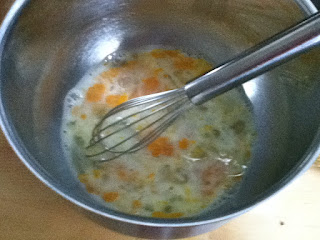It's April near Paris, and you know what that means...cold, windy, rainy weather. I still wouldn't go so far as to call it the cruelest month. That would be November. But April also means the beginning of spring produce: strawberries, sorrel, peas, spring onions, asparagus.
Northern Europeans, however, seem to appreciate white asparagus more than the green stuff. I personally could never make friends with white asparagus: it requires peeling, and even then it can be stringy. So I was delighted to find beautiful green asparagus at a roadside market while we were on the return trip from vacation.
This dish involves three basic elements: toasted breadcrumbs flavored with anchovy, lemon zest, and garlic; asparagus that's been roasted on the stovetop, and fried eggs that create a bit of a sauce and make the dish substantial enough for lunch.
The asparagus comes out of the pan somewhat toasty but also tender-crisp. However, I made the mistake of using the wrong kind of oil (the "good" olive oil, meant to be used as a finishing oil ) and overheating the pan: the asparagus picked up an unpleasant burnt-oil taste. I haven't had this problem roasting my asparagus in the oven, so I would recommend using a "normal" olive oil and the oven.
The bread crumbs were controversial: Claire immediately picked up on the fishy taste and was not happy about it. I thought it was kind of OK, but the dish would also have been good without the anchovy. Maybe even better.
And finally, the fried eggs. I picked up an awesome technique from Elle magazine: You can fry eggs in the oven! I put a bit of olive oil in my nonstick (oven-safe) skillet, cracked the eggs into it, and put the skillet in a 350 oven for 5 minutes--the eggs and asparagus started cooking at about the same time. They turned out great: the whites were completely set (which is normally a problem for me), but the yolks were still nice and runny.
I liked this dish, and I think it has the potential to be something I love. Changes I would make would be to roast the asparagus in the oven (since I would be turning it on for the eggs anyway) and to replace the anchovy with Parmesan. With those changes, I think it would make a perfect springtime lunch/brunch dish.


















